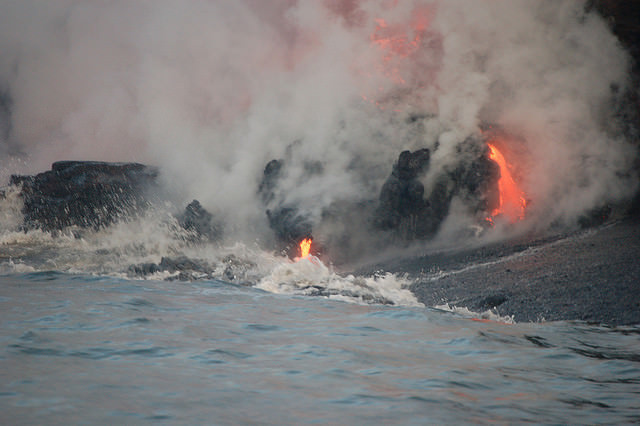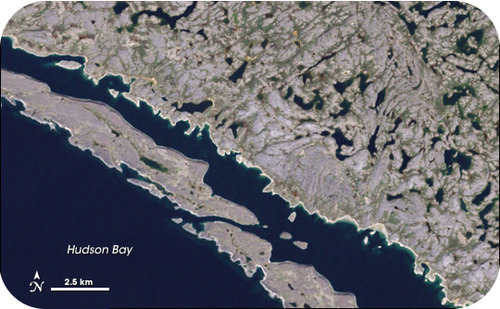前寒武纪大陆
章节大纲
-
When did Earth become a dynamic planet?
::地球何时变成一个充满活力的星球?Earth was always dynamic! Earth has changed many times over billions of years. Huge mountains have formed, been destroyed, and been replaced with new mountains. Continents have moved, split apart, and collided with each other. Ocean basins have opened up. Life on Earth evolved slowly for billions of years.
::地球总是充满活力的!地球在数十亿年的时间里发生了许多变化。巨大的山脉已经形成,被摧毁,并被新的山脉所取代。大陆已经移动,分裂,并相互碰撞。海洋盆地已经开张。地球上的生命已经缓慢地演变了数十亿年。Early Continents
::早期大陆The earliest crust was probably basalt. It may have resembled the current . This crust formed before there were any oceans. More than four billion years ago, continental crust appeared. The first continents were very small compared with those today.
::最早的地壳可能是岩石。 它可能与洋流相似。 地壳在海洋出现之前就形成。 超过40亿年前,大陆地壳出现了。 与今天相比,第一批大陆非常小。Continents Grow
::种植大陆Continents grow when microcontinents , or small continents, collide with each other or with a larger continent . Oceanic island arcs also collide with continents to make them grow.
::当微大陆或小大陆相互碰撞或与更大的大陆相撞时,大陆就会增长。 海洋岛也与大陆相撞,以使它们成长。Cratons
::The earliest continental crust is now found in the ancient cores of continents, called the cratons . Geologists can learn many things about the Precambrian by studying the of the cratons.
::最早的大陆地壳现在存在于古老的大陆核心中,即所谓的巨石。 地质学家可以通过研究巨石来了解许多关于波坎布里安的事物。- Cratons contain felsic , which are remnants of the first continents.
::珊瑚板含有水果,是第一大洲的残余物。
- Cratonic rocks contain rounded sedimentary grains. Rounded grains indicate that the eroded from an earlier rock. It also means that rivers or seas existed.
::龙卷风岩含有四舍五入的沉积颗粒,四舍五入的粒子表明从早期的岩石中侵蚀的粒子,也意味着存在河流或海洋。
- One common rock type in the cratons is greenstone , a metamorphosed volcanic rock ( Figure ). Since greenstones are found today in oceanic trenches , what does the presence of greenstones mean? These ancient greenstones indicate the presence of subduction zones .
::巨石中一种常见的岩石类型是绿石,一种变形火山岩(Figure ) 。 由于如今在海洋战壕中发现了绿石,因此绿石的存在意味着什么?这些古老的绿石表明存在稀释区。
Ice age glaciers scraped the Canadian Shield down to the 4.28 billion year old greenstone in Northwestern Quebec.
::冰河时代的冰川将加拿大的盾牌刮了下来, 直至魁北克西北部42.8亿亿年前的绿石。Supercontinents
::超级多污染物There are times in Earth history when all of the continents come together to form a supercontinent . Supercontinents come together and then break apart. Pangaea was the last supercontinent on Earth, but it was not the first. The supercontinent before Pangaea is called Rodinia. Rodinia contained about 75% of the continental landmass that is present today. The supercontinent came together about 1.1 billion years ago. Rodinia was not the first supercontinent either. Scientists think that three supercontinents came before Rodina, making five so far in Earth history.
::在地球历史上,有时所有大陆都聚集在一起形成超级大陆。超级大陆聚集在一起,然后分裂。南洋是地球上最后一个超级大陆,但不是第一个。南洋是地球上最后一个超级大陆,但不是第一个。南洋之前的超大陆称为罗迪尼亚。罗迪尼亚拥有今天存在的大约75%的大陆陆地。超级大陆在11亿年前聚集在一起。罗迪尼亚也不是第一个超级大陆。科学家们认为三个超级大陆都来到了罗迪纳之前,在地球史上达到了5个。Early Plate Tectonics
::早期热板构造Since the early Earth was very hot, mantle convection was very rapid. Plate tectonics likely moved quickly. The early Earth was an active place with abundant volcanic eruptions and . The remnants of these early rocks are now seen in the ancient cores of the continents.
::早期的地球非常热, 地壳对流速度非常快。 板块构造可能移动得很快。 早期的地球是一个充满火山爆发的活跃地。 这些早期岩石的残余现在可见于大陆的古代核心。Further Reading
::继续阅读Paleozoic Plate Tectonics
::Paleozoic 热热板构造构造学Summary
::摘要- The first crust was basalt. It resembled the modern seafloor.
::第一个地壳是玄武岩 类似于现代海底
- Microcontinents come together to create continents and supercontinents.
::微污染物聚集一堂 创造大陆和超大陆
- Convection on early Earth was faster and so plate tectonics was faster. Since then, Earth has been cooling.
::早期地球的对流速度更快,因此板块构造速度更快。从那时以来,地球一直在冷却。
Review
::回顾- What were the first continents like?
::第一大陆是什么样的?
- Where do we find the oldest crust we can find? Is this what is left of the first crust? How do we know?
::我们在哪里能找到最古老的地壳?这是第一块地壳留下的吗?我们怎么知道?
- What are supercontinents? How do we know of their existence (think back to the concepts in the Plate Tectonics chapter)?
::超级大陆体是什么?我们怎么知道它们的存在(回想一下板块构造一章中的概念)?
- Why was plate tectonics faster in the early Earth?
::为什么早期地球的板块构造速度更快?
Explore More
::探索更多- What did the early Earth look like?
::早期地球长什么样?
- Why do some scientists think that life may have originated more than once?
::为什么有些科学家认为 生命起源不止一次?
- What landmasses existed 2.5 billion years ago?
::25亿年前,哪些地产是存在的?
- When did Arctica take shape?
::北极是什么时候形成的?
- What was Rodinia?
::什么是罗迪尼亚?
- What came together to form Pangaea and when did this happen?
::是什么形成了潘加亚? 这是什么时候发生的?
- What is driving the movement of the plates?
::驱动牌照运动的是什么?
- What is convective flow?
::什么是对流流?
- Where does the energy come from to drive plate movements?
::车牌移动的能量来自何方?
- What material is found in the core that makes it hot?
::核心中找到什么材料能让它发热?
- Cratons contain felsic , which are remnants of the first continents.

